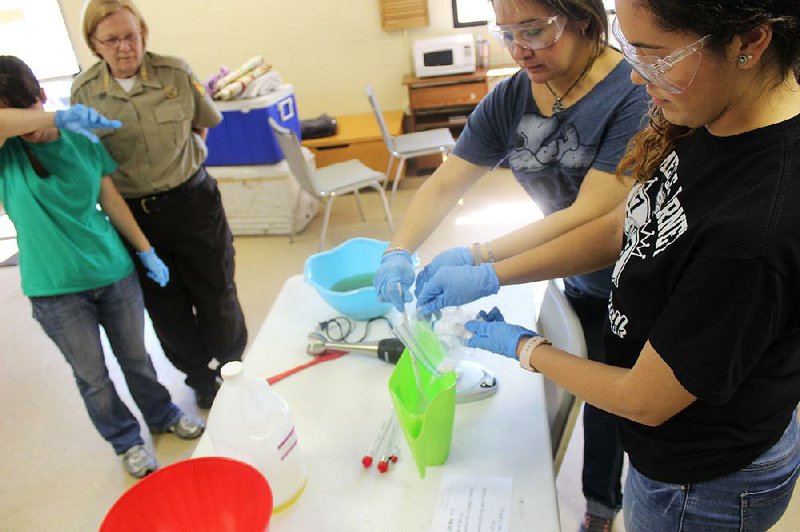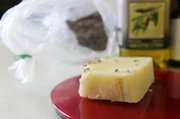SCOTT -- The first thing one learns when making soap is that there is a lot of stirring involved. And trickling. And waiting. And hoping not to blow anything up.
But, boy, does it smell good.
An eager group of six soap-making novices has gathered on a crystal clear Saturday morning to take part in the Lye Soap Making Workshop at Plantation Agriculture Museum State Park in Scott, using alchemy and patience to make soap they can scrub with at home or give as gifts.
Just not right away.
Leading the crew toward homemade cleanliness are park interpreter Betty Coors and former interpreter Lydia Leatherwood.
There are just a few basic items needed to make soap from scratch, says soap-making enthusiast Leatherwood, who left her state parks job for full-time motherhood but returned for this class to help Coors.
Lye, fats or oils and water are the core ingredients, and the process of mingling them to produce soap is called saponification. Goodies like essential oils, honey or even oats will come later.
Assembled on folding tables in the cinder block Heritage Resource Center building next to the museum are the ingredients needed to make soap from scratch as the workshop participants, who have all paid $25 for the class, split into pairs and set into motion the chemical sorcery needed to make a bar of soap. There is a bag of lye chips, olive oil, essential oils, tallow or lard, scales, plastic containers and neat little wooden molds in which to pour the soap fixin's.
Soap has been around for a while. Clean freaks in Babylon were using it as early as 2800 B.C. Roman men were using a soap-like pomade to style their hair and by the middle of the 15th century, pros were manufacturing it on a small scale in France and England. American colonists were even using a form of liquid soap, Leatherwood says.
For Leatherwood, making soap from scratch "takes us back to our roots and reminds us where we came from."
Coors says, "Soap-making appeals to the back-to-nature, take-care-of-yourself side of me. It is both an art and a craft. If I want ... purple soap with orange swirls that smells like lemons, I can make that."
Handmade soap also contains skin-moisturizing glycerine, she says, which is drained from many store-bought soaps and leaves the skin dry.
"When you make your own soap, you don't have to wonder what you're putting on your skin," Coors says.
The soap-makers gathered in Scott are purely amateurs, although two in the class have taken it before.
"I have fun taking these classes," says second-timer Betsy Otwell of Little Rock.
Sharon Staton of Lonoke had such a good time at an earlier class that she brought her sister, Gwen Staton of Carlisle, this time around.
Ana Wilson, a recent high-school graduate from Maumelle, says with a laugh, "I'm here because my Mom made me."
Her mother, Kazandra Wilson of Maumelle, admits, "I'm the mean mom. We were visiting the museum a few weeks ago and saw the ad and thought it looked really interesting."
Soap-making can be hazardous. Blame the lye. Get that stuff on your skin and it burns mightily, so there is water and spray bottles of lye-countering vinegar on hand. Students are also encouraged to wear long sleeves and closed-toe shoes. Latex gloves are provided, as are goggles.
The lye also has to be properly mixed with water. Pouring a pitcher of water over a bunch of lye in a bowl can lead to explosive results, Coors says. Lye must be added to the water, not the other way around. This is why there are numerous signs posted around the room of a giraffe floating in water reading, "Remember ... lye in the water."
This solution is trickled gently into a container of heated oil or fat, but only after everything has reached a temperature of about 115-120 degrees. And then it's time pick up a plastic spoon and stir.
And stir.
And stir.
Leatherwood and Coors frequently check on each station to make sure everyone knows that it is not time to stop stirring.
The goal is to bring the water-lye-fat concoction to something resembling pudding and, after a spell of using spoons then gently pulsing with a stick blender, the various mixes do take on a pudding-like look. One batch in particular looks as if all it needs to be the star of the church potluck is some sliced bananas and vanilla wafers.
After mixing in things like honey, shea butter, essential oils or oats, the goopy goodness is poured into the molds and, yea! Now everyone can get clean!
Well, not right away.
"Notice I'm not touching this," Coors says as she shows off a bar of soap sitting on a piece of paper in her hand. It was from a batch she made a week earlier that hadn't completely cured, which means the lye was still a threat. "You still can't touch it after a week with your bare hands. It will burn you."
Stupid lye.
In fact, it will be 60 days before the workshop participants can use their soap. Coors will keep the molds stored at the park and will contact everyone after a month, though they have to promise to not use their soap for another 30 days just to be safe.
The results will yield 75-80 bars of soap to be shared among participants, Coors says, with each batch running about 4-5 pounds and "the building should smell great for at least a month."
Soap-making workshops return to the Agriculture Museum starting at 9 a.m. Saturday, Aug. 5 and again on Saturday, Nov. 4. The fee is $25. For information, visit arkansasstateparks.com/plantationagriculturemuseum or call (501) 961-1409.
Let's Do This is an occasional column of things to do off the beaten path in the Natural State. Have a suggestion? Email:
Style on 07/04/2017


